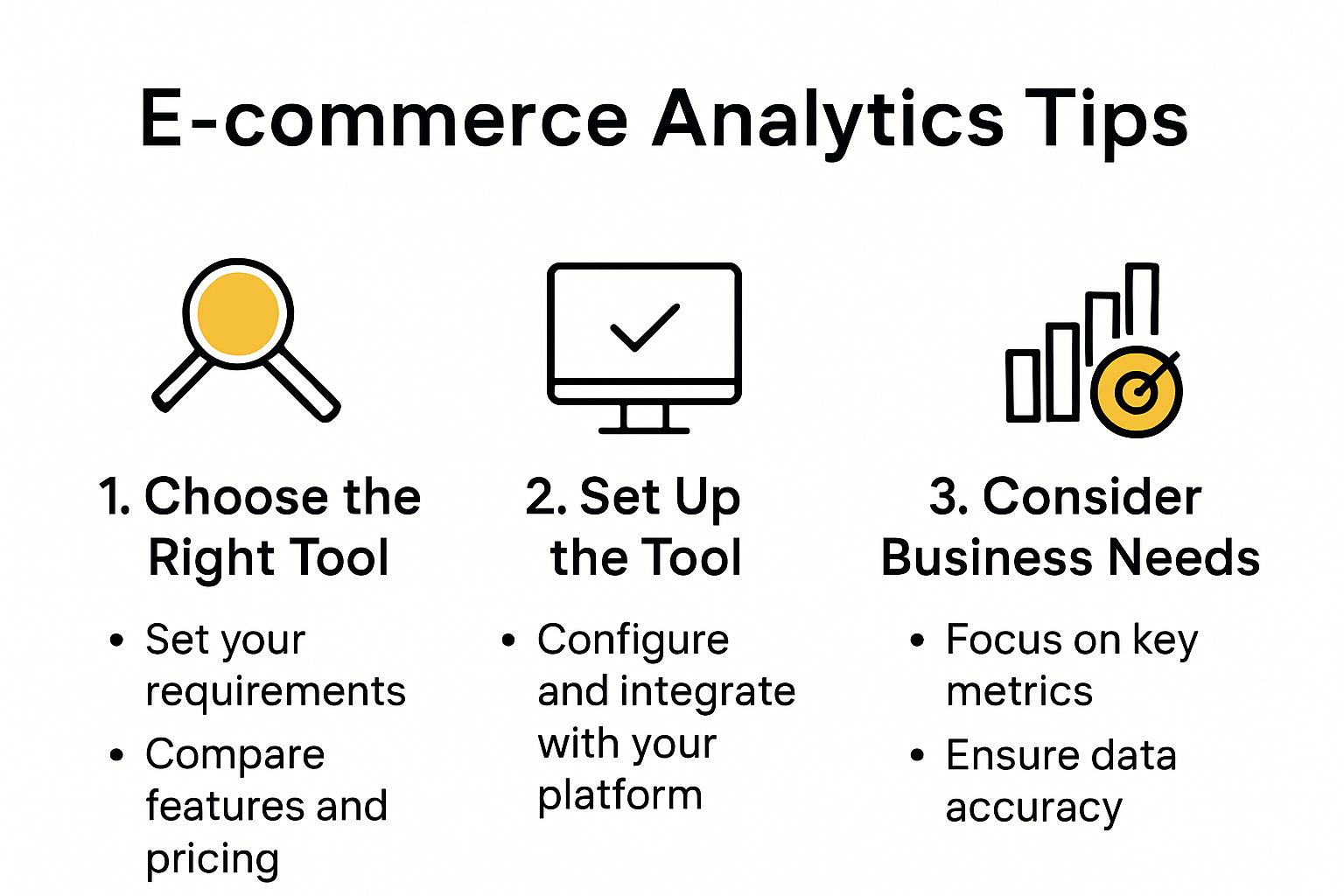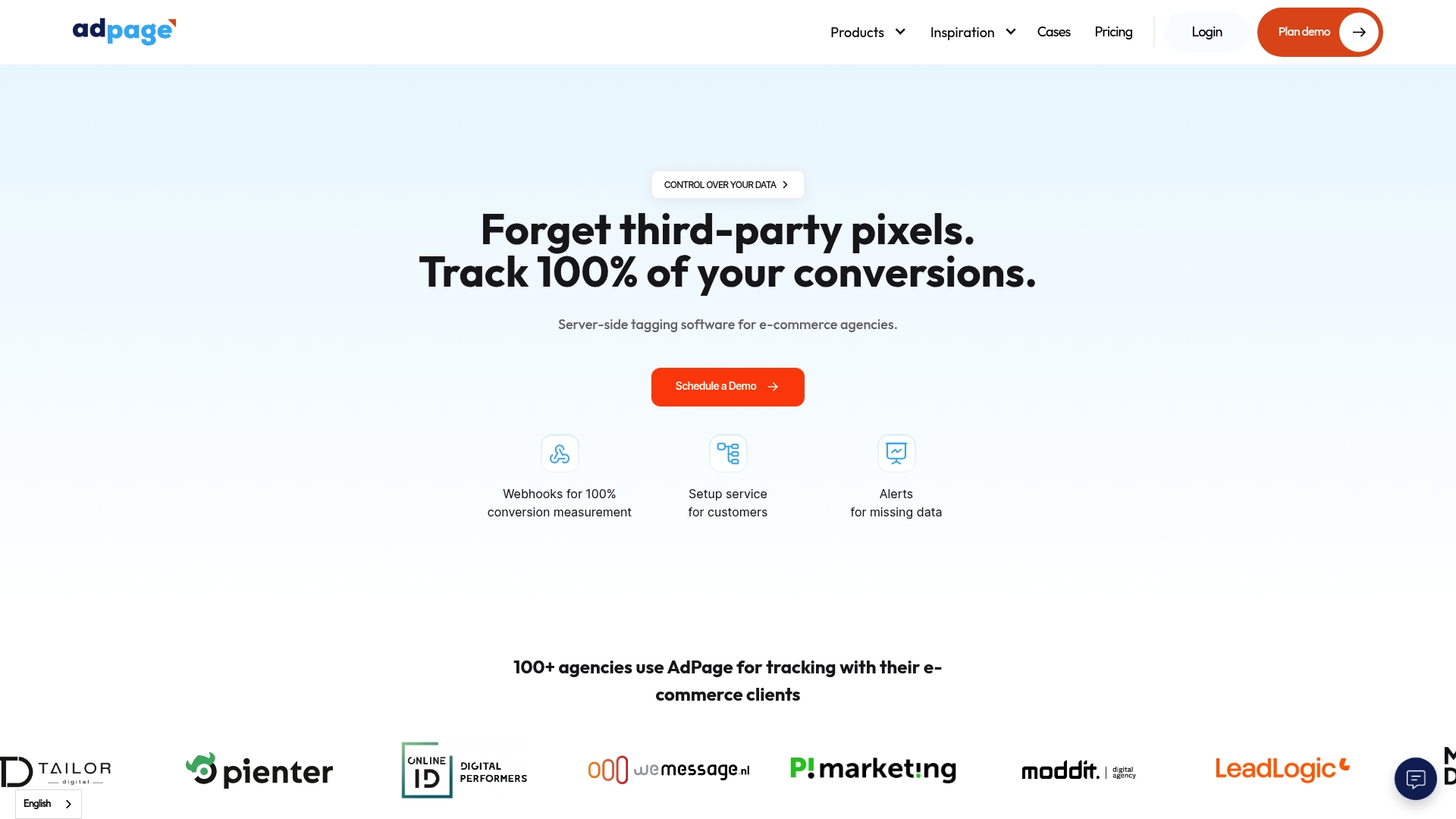E-commerce marketing is becoming a high-tech puzzle, with new strategies and analytics surfacing at record speed. Here is something striking. A one second delay in website speed can lead to a 7 percent drop in conversions. You might expect the biggest success factor is clever branding or viral ads, but the real winner? It is understanding the quiet power of analytics and using it to turn every click into meaningful insight.
Table of Contents
- Getting Started With Marketing Analytics Tools
- Essential Marketing Metrics Every Brand Should Track
- Practical Tips To Improve Conversion Rates
- Advanced Strategies For Accurate Customer Insights
Quick Summary
| Takeaway | Explanation |
|---|---|
| Identify Analytics Requirements | Conduct a comprehensive assessment of your analytical needs, focusing on data collection, scalability, and reporting flexibility before selecting marketing analytics tools. |
| Track Essential Metrics | Monitor key performance indicators such as conversion rates, customer lifetime value, and engagement metrics to gain insights into customer behavior and enhance marketing strategies. |
| Enhance Website Performance | Prioritize website speed and mobile responsiveness to improve user experience, as even minor delays can significantly impact conversion rates. |
| Build Customer Trust | Incorporate user-generated content and transparent pricing to foster trust, as this can lead to higher conversion rates and customer satisfaction. |
| Leverage Advanced Analytics | Use intelligent data mining and sentiment analysis to gain deeper customer insights and adapt marketing efforts proactively to meet evolving customer needs. |
Getting Started with Marketing Analytics Tools
Marketing analytics tools have become essential for e-commerce businesses seeking data-driven insights and competitive advantages. Understanding how to select and implement the right tools can transform your marketing strategy from guesswork to precision.

Identifying Your Analytics Requirements.
Before diving into tool selection, businesses must conduct a comprehensive assessment of their specific analytical needs. The UK Government's Service Manual recommends evaluating key factors such as data collection capabilities, budget constraints, and integration potential.
Successful marketing analytics implementation requires a strategic approach. Consider these critical evaluation points:
- Data Granularity: Determine the level of detailed insights you require about customer behaviors and conversion pathways.
- Scalability: Choose tools that can grow alongside your e-commerce operations.
- Reporting Flexibility: Ensure the platform offers customizable reporting options matching your business intelligence needs.
Professionals must understand that not all analytics tools are created equal. Some focus on website traffic, while others specialize in conversion tracking, customer segmentation, or comprehensive performance monitoring.
Implementing Analytics Best Practices
According to the National Occupational Standards, digital marketing professionals should prioritize systematic research and precise tool selection. This involves conducting thorough competitor and sector analysis to benchmark your performance effectively.
Key implementation strategies include:
- Establishing clear measurement objectives before tool deployment
- Configuring tracking mechanisms to capture relevant data points
- Creating baseline performance metrics for comparative analysis
For those seeking structured learning, the University of Aberdeen offers comprehensive online courses through Google Analytics Academy. These resources provide invaluable insights into account creation, tracking code implementation, and advanced reporting techniques.
Continuous Learning and Adaptation
Marketing analytics is not a one-time setup but an ongoing process of refinement. Successful e-commerce businesses treat their analytics infrastructure as a dynamic ecosystem requiring constant attention and strategic adjustment.
Effective analytics management involves:
- Regular performance reviews
- Staying updated with emerging tracking technologies
- Adapting measurement strategies based on evolving business goals
Remember that raw data alone provides little value. The true power of marketing analytics lies in transforming complex datasets into actionable strategic insights that drive meaningful business decisions. By approaching analytics with a structured, methodical mindset, e-commerce businesses can unlock unprecedented understanding of their customer journeys and optimize their marketing investments.
Navigating the complex world of marketing analytics requires patience, continuous learning, and a commitment to data-driven decision-making. Your journey begins with selecting the right tools and developing a robust analytical framework tailored to your unique business objectives.
Essential Marketing Metrics Every Brand Should Track
In the competitive world of e-commerce, understanding and tracking the right marketing metrics can make the difference between business success and stagnation. These key performance indicators provide critical insights into your brand's digital performance and customer engagement strategies.
Conversion-Focused Performance Metrics
Conversion metrics sit at the heart of e-commerce analytics. According to FutureLearn's E-commerce Analysis Course, conversion rate represents the percentage of website visitors who complete a specific desired action.
Critical conversion-related metrics include:
- Conversion Rate: Measures the percentage of visitors completing a purchase
- Cart Abandonment Rate: Tracks potential lost revenue from incomplete transactions
- Cost per Acquisition: Calculates the total expense of converting a potential customer
Businesses must look beyond surface-level numbers. A low conversion rate might indicate issues with website design, pricing strategy, or user experience. Continuous monitoring allows for targeted improvements and more efficient marketing spend.
Customer Value and Revenue Metrics
Understanding customer economic dynamics goes far beyond simple transaction tracking. The Digital Culture Network emphasizes the importance of comprehensive value measurement.
Key metrics in this category include:
- Customer Lifetime Value (CLV): Predicts total revenue from a single customer relationship
- Average Order Value (AOV): Tracks the average amount spent per transaction
- Repeat Purchase Rate: Indicates customer loyalty and product satisfaction
CLV provides profound insights into long-term business potential. By understanding how much value each customer brings over time, brands can make more informed decisions about marketing investments and customer retention strategies.
Engagement and Retention Analytics

Engagement metrics reveal the depth of customer interaction with your brand beyond mere transactions. These indicators help understand customer sentiment, brand perception, and potential areas for improvement.
Essential engagement metrics include:
- Website Traffic Sources: Identifies most effective marketing channels
- Time on Site: Measures user interest and content relevance
- Social Media Interaction Rates: Tracks brand visibility and audience connection
Successful e-commerce brands recognize that metrics are not just numbers but storytellers. Each data point represents a customer journey, a potential opportunity, or an area requiring strategic intervention.
Navigating the complex landscape of marketing metrics requires a holistic approach. While individual metrics provide valuable snapshots, their true power emerges when analyzed collectively. Brands must develop a nuanced understanding of how these indicators interconnect and influence overall business performance.
Remember, metrics are tools for strategic decision-making. They transform raw data into actionable insights, enabling brands to refine marketing strategies, optimize customer experiences, and drive sustainable growth in the competitive e-commerce marketplace.
To help readers quickly compare and understand the key e-commerce metrics discussed above, the following table organizes conversion, value, and engagement metrics with their core definitions:
| Metric Category | Metric | What It Measures / Indicates |
|---|---|---|
| Conversion Performance | Conversion Rate | % of visitors who complete a purchase |
| Conversion Performance | Cart Abandonment Rate | % of transactions started but not completed |
| Conversion Performance | Cost per Acquisition | Total spend required to acquire one paying customer |
| Customer Value & Revenue | Customer Lifetime Value | Predicted total revenue from a single customer |
| Customer Value & Revenue | Average Order Value | Average amount spent per transaction |
| Customer Value & Revenue | Repeat Purchase Rate | % of customers making more than one purchase |
| Engagement & Retention | Website Traffic Sources | Identifies most effective incoming marketing channels |
| Engagement & Retention | Time on Site | Average duration users spend on the website |
| Engagement & Retention | Social Media Interaction | Level of brand engagement on social channels |
Practical Tips to Improve Conversion Rates
Converting website visitors into paying customers remains the ultimate goal for e-commerce businesses. Improving conversion rates requires a strategic approach that combines technical optimization, user experience design, and psychological understanding of customer behavior.
Website Performance and User Experience
Website speed directly impacts conversion potential. Chargebee's E-commerce Research reveals that a single second of delay can reduce conversions by 7%. This means every millisecond counts in maintaining user engagement.
Key performance optimization strategies include:
- Rapid Page Load Times: Compress images, leverage browser caching
- Mobile Responsiveness: Ensure seamless experience across all devices
- Clear Navigation: Simplify user pathways to critical pages
Technical performance is not just about speed but creating a frictionless browsing experience that encourages users to complete their purchase journey.
To provide a practical overview, the following table summarizes the main e-commerce conversion obstacles highlighted in this section, along with the associated statistics and recommended solutions:
| Obstacle | Statistic/Impact | Recommended Solution |
|---|---|---|
| Website Load Delay | 1 sec delay = 7% drop in conversions | Optimise images, enable caching |
| Lack of Mobile Responsiveness | Users may abandon on non-mobile sites | Ensure mobile-first site design |
| Complex Checkout | 18% abandon orders due to checkout complexity | Simplify checkout, enable guest checkout |
| Lack of Trust Content | UGC can boost conversions by up to 200% | Add reviews/photos, show badges |
Content and Trust Signals
User-generated content plays a crucial role in building customer trust. According to Yotpo's Conversion Analysis, incorporating customer reviews and photos can dramatically increase conversion rates by up to 200%.
Effective trust-building techniques involve:
- Authentic Customer Reviews: Display unfiltered feedback
- Transparent Pricing: Show all costs upfront
- Security Badges: Highlight payment and data protection credentials
Customers seek reassurance before making purchasing decisions. Providing social proof and transparent information reduces purchase hesitation.
Checkout Process Optimization
The checkout stage represents a critical conversion point. Baymard Institute's Research indicates that 18% of users abandon orders due to complicated checkout processes.
Streamlining checkout involves:
- Minimalist Design: Reduce form fields
- Multiple Payment Options: Accommodate Diverse Customer Preferences
- Guest Checkout: Allow purchases without mandatory account creation
A smooth, intuitive checkout experience can significantly reduce cart abandonment rates and improve overall conversion performance.
Successful conversion rate optimization is an ongoing process of testing, learning, and adapting. By focusing on technical performance, building trust, and simplifying user interactions, e-commerce businesses can create compelling digital experiences that transform casual browsers into loyal customers.
Remember that conversion rate improvement is not about manipulating users but genuinely understanding and addressing their needs. Each optimization should prioritize user experience, transparency, and value delivery.
Advanced Strategies for Accurate Customer Insights
Customer insights have evolved far beyond traditional analytics, entering a sophisticated era of predictive intelligence and nuanced behavioral understanding. Modern e-commerce businesses must leverage advanced techniques to decode complex customer interactions and anticipate future trends.
Intelligent Data Mining and Predictive Analysis
Advanced data mining techniques are transforming how businesses understand customer behavior. According to research published on arXiv, integrating predictive modeling and association rule mining enables businesses to identify intricate buying patterns and forecast demand variations with unprecedented accuracy.
Key strategies in this domain include:
- Time-Series Forecasting: Predicting future purchasing trends
- Association Rule Mining: Discovering hidden relationships between product purchases
- Demand Variation Modeling: Understanding seasonal and contextual buying behaviors
By applying these sophisticated analytical approaches, businesses can move beyond reactive strategies to proactively shape their marketing and inventory management.
Sentiment Analysis and Behavioural Intelligence
Understanding customer emotions and perceptions has become a critical competitive advantage. AI-driven sentiment analysis research demonstrates remarkable accuracy of 89.7% in interpreting customer feedback and interactions across diverse datasets.
Advanced sentiment intelligence techniques involve:
- Emotion Mapping: Tracking customer sentiment across different touchpoints
- Contextual Feedback Analysis: Understanding nuanced customer expressions
- Predictive Emotional Modeling: Anticipating customer reactions before they occur
These approaches transform raw customer data into actionable emotional intelligence, enabling more empathetic and targeted marketing strategies.
Recommendation Systems and Personalization
Personalized customer experiences are no longer optional but expected. Behavioural recommendation system research highlights sophisticated methods of generating tailored product suggestions based on intricate user actions like browsing patterns and interaction histories.
Key personalization strategies include:
- Dynamic Product Recommendations: Adapting suggestions in real time
- Contextual Relevance Scoring: Matching products to specific user profiles
- Cross-Channel Preference Tracking: Understanding customer preferences across multiple platforms
Successful customer insight strategies transcend mere data collection. They represent a holistic approach to understanding human behavior, combining technological sophistication with genuine empathy and customer-centric thinking.
The future of e-commerce insights lies in creating intelligent, adaptive systems that can predict, understand, and proactively respond to customer needs. By embracing these advanced analytical approaches, businesses can transform raw data into meaningful, actionable intelligence that drives genuine customer engagement and long-term loyalty.
Frequently Asked Questions
What are the essential marketing metrics every e-commerce brand should track?
Every e-commerce brand should monitor conversion rates, customer lifetime value, average order value, cart abandonment rates, and engagement metrics like website traffic sources and time on site to gain insights into customer behavior and enhance marketing strategies.
How can I improve my e-commerce conversion rates?
To improve conversion rates, focus on enhancing website performance by optimizing load times, ensuring mobile responsiveness, simplifying navigation, and streamlining the checkout process. Additionally, build customer trust through user-generated content and transparent pricing.
Why is continuous learning important in marketing analytics?
Continuous learning allows e-commerce businesses to adapt to emerging technologies, evolving customer needs, and changing market conditions. Regular performance reviews and the refinement of measurement strategies ensure that analytics effectively drive informed decision-making.
What are advanced strategies for gaining customer insights in e-commerce?
Advanced strategies include intelligent data mining for predictive analysis, using sentiment analysis to understand customer emotions, and implementing recommendation systems for personalized experiences, which can significantly enhance customer engagement and loyalty.
Boost E-commerce Precision With Unmatched Conversion Analytics
E-commerce growth in 2025 relies on more than smart branding and quick site performance. The true challenge is data loss from outdated analytics, leading to blind spots in your conversion strategy. The article showed how a single delay or missed data point can cause significant drops in conversion. Do you recognize these pain points? Struggling with incomplete tracking, unreliable insights, or wasted ad spend due to browser restrictions and consent complications? You are not alone. Many brands still rely exclusively on legacy client-side tracking, which delivers only part of the picture.

Now is the time to fight back and claim total visibility for your business. AdPage delivers server-side tagging that empowers marketing agencies and online retailers to capture every conversion, even when browsers block scripts or visitors opt out of cookies. You can easily integrate with platforms like Shopify, WooCommerce and Magento, while safeguarding data with GDPR-ready consent management and precise reporting tools. See how your next campaign can reach its full potential. For those ready to gain a competitive edge and put an end to missing conversions, dive into our comprehensive e-commerce solution today.



.png)
